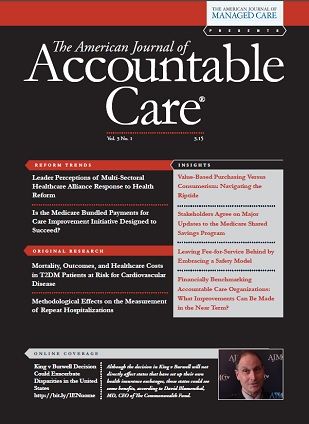Publication
Article
Population Health, Equity & Outcomes
Stakeholders Agree on Major Updates to the Medicare Shared Savings Program
Author(s):
Public comments on the first ever update to the Medicare Shared Savings Program are in. Conceptually, there is an astounding level of consensus, but it is the details that can make or break an ACO.
New announcements between healthcare providers and commercial insurers seem to come about every month regarding new accountable care arrangements, but—just as in fee for service—the largest single player is Medicare. Based on 2012 and 2013 figures, the Medicare Shared Savings Program (MSSP) has already distributed over $300 million to participating accountable care organizations (ACOs), and 2014 results are still to come.
Because it is a government program controlled by strict regulations, the ability to update the MSSP is a rare opportunity—the first of which came 3 years, 1 month, and 6 days after the MSSP was formally created with the publication of a notice of proposed rule making.1 Eagerly anticipated by ACOs and policy shops alike, the new proposed rule had to lay out what happens when an ACO finishes its first contract. It was widely and correctly assumed that the changes would attempt to address the current unattractiveness of the 2-sided risk option known as Track 2. Also covered were the ideas first introduced in the Pioneer ACO program2 of waivers for certain payment policies, as well as the concept of prospective attribution.
All told, CMS received 338 public comments on the proposed changes to the MSSP, and there is a rather astonishing degree of accord among those comments. There is near-universal agreement that:
• One-sided risk (Track 1) should remain an option for ACOs in their second 3-year contract.
• Medicare beneficiaries should have the option to choose their primary care provider (in addition to and ahead of the current “vote with your feet” model).
• Two-sided risk must become attractive if ACOs are to choose it.
• The proposed Track 3 model is much more attractive to ACOs than the current or proposed Track 2.
• The critical role nurse practitioners, physician assistants, and certified nurse specialists play in primary care should be acknowledged by moving them to step 1 of the assignment model.
• Getting timely, accurate, and complete data is an ongoing process that CMS should continually work to improve upon, never settling for yesterday’s solution.
• All ACO formulas and calculations, including risk adjustment, benchmarking, and assignment of beneficiaries, should be completely transparent (ie, CMS should provide the code used, not details on how to recreate the code).
The more one delves into the details, the harder it becomes to achieve consensus among a large group, as in the example of the continuation of 1-sided risk in the second contract of an ACO. Every comment I have read supports the continuation of 1-sided risk; however, the details vary rather dramatically. Some commenters representing large but specific constituencies such as NAACOS support allowing nearly any ACO to continue in 1-sided risk. Other comments from policy shops like Brookings, where 2-sided risk is cherished, suggest tougher requirements (eg, requiring an ACO to have achieved 1 year of shared savings in order to continue in 1-sided risk). Others, including Aledade, focus both on recognizing that ACOs come in all sizes and forms and on including policies that would acknowledge those differences (eg, requiring that ACOs with large institutional partners have achieved shared savings in at least 1 of the 3 years of the first contract).
Another avenue—especially in light of the recent antitrust case in Idaho that went against a hospital and large physician practice merger3—is to evaluate ACOs for market consolidation and require that if they dominate their local healthcare market they move to 2-sided risk. These policies will prevent large institutions and dominant market players from “squatting” in 1-sided risk. Thus, there is universal agreement on the continuation of 1-sided risk, but disagreement on the criteria. Rarely do regulators impose more restrictions on those they regulate than what was proposed initially, so one would expect that given the range of comments received, CMS would likely finalize something similar—possibly accounting for elements not addressed in the proposed rule, like market consolidation.
The next hot topic is how to rebase the benchmark for the second contract. Again, at the highest level, everyone supports having the option for a benchmark not based on the ACO providers’ historical costs, but rather on a risk-adjusted regional benchmark. However, some commenters want this to be an individual choice that each ACO makes (ie, choose a historical cost benchmark or regional benchmark) with no requirement to move to regional. Meanwhile, others believe that all ACOs should move to a regional benchmark, but they are divided between requiring a defined transition path and letting an ACO choose its own. Furthermore, defining the region, the comparison population, and risk adjustment are all critical details that some commenters recommended leaving to CMS to work out on their own, but others deemed it necessary to provide their implementation details to CMS. A regional benchmark would offer long-term stability to the MSSP, and so CMS should review every proposal made by the commenters to start working on perfecting this benchmark.
Risk adjustment is another area where the details see a little divergence. While nearly all commenters believe that risk adjustment should be allowed to move up as well as down, how far it should be able to go up—in other words, whether upward adjustment should be limited to a national average or other ceiling, or not limited at all—is what is being debated. In addition to comments on whether the current risk adjustment methodology should be allowed to adjust upward as well as downward, there are comments questioning whether the current risk adjustment model is the right one. Various commenters support alternative models such as aligning the model more closely with Medicare Advantage (MA), and changing the model to a true concurrent model. MSSP is a unique program with distinct differences from MA, and everyone should be wary of moving toward MA due to familiarity rather than the pursuit of ideal program design.
I would like to end on one of those rare opportunities to “have your cake and eat it too.” ACOs are divided over whether prospective attribution or retrospective attribution is better, with some craving the certainty of the prospective attribution. Other ACOs balk at the idea that a beneficiary who did not receive care from them would be in the ACO, or that a beneficiary who did receive care from them would not be. Either way, both are concerned with uncertainty, but it is important to keep in mind that this is not an either/or situation. Ultimately, the closer the prospective attribution matches the retrospective attribution, the more certainty everyone has.
Therefore, the path forward is to refine prospective and retrospective attribution so that the difference between the two disappears. HTTF, Brookings, Aledade, and others included proposals that would improve attribution, and CMS also proposed some great changes to the MSSP, as evidenced by the quite astounding level of support for many of the changes. With 338 comments to work from, CMS has a lot of a lot of ideas and designs to draw upon as it considers the finalization of this first major refresh of the MSSP.Author Affiliation: Aledade, Inc, Bethesda, MD.
Source of Funding: None.
Author Disclosures: Mr Broome reports no conflicts of interest.
Address correspondence to: Travis Broome, MPH, MBA, Aledade, Inc, 7315 Wisconsin Blvd, Ste 1000E, Bethesda, MD 20814. E-mail: travis@aledade.com.REFERENCES
1. Medicare Program: Medicare Shared Savings Program—Accountable Care Organizations (CMS-1461-P) [proposed rule]. Regulations.gov website. http://www.regulations.gov/#!documentDetail;D=CMS-2014-0155-0002. Posted December 8, 2014. Accessed February 22, 2015.
2. Pioneer ACO Model. CMS website. http://innovation.cms.gov/initiatives/Pioneer-aco-model/. Accessed February 22, 2015.
3. St Alphonsus Med Ctr v St Luke’s Health Sys. No. 14-35173. (9th Cir 2015). http://cdn.ca9.uscourts.gov/datastore/opinions/2015/02/10/14-35173.pdf. Accessed February 22, 2015.

2 Commerce Drive
Suite 100
Cranbury, NJ 08512
© 2025 MJH Life Sciences® and AJMC®.
All rights reserved.






